Abstract
1. These experiments were designed to measure how much blood is mobilized from or pooled in the liver, spleen and gastro-intestinal tract to compensate for a haemorrhage or infusion of blood.
2. Hepatic volume, splenic weight and intestinal volume were recorded in cats anaesthetized with sodium pentobarbitone. Whole blood was removed or infused at rates of 0·5-0·6 ml. kg-1.min-1 until 10 ml./kg (19% blood volume) had been removed or 18 ml./kg (34% blood volume) had been infused. These blood volume changes produced only small changes in arterial and portal pressures except after removal of 8 ml./kg (15% blood volume) when arterial pressure began to decrease rapidly.
3. With small haemorrhages of up to 4% blood volume, the liver contributed 16%, the gastro-intestinal tract 23% and the spleen a negligible proportion of the blood volume removed. With haemorrhages of 15% blood volume, the liver contributed 21%, the gastro-intestinal tract 22% and the spleen 19% of the volume removed; a total splanchnic contribution of 62%.
4. During infusions of 5-18 ml./kg (10-34% blood volume), the liver pooled 20%, the gastro-intestinal tract 40% and the spleen 6% of the volume infused; a total splanchnic contribution of 66%.
5. It is concluded that the splanchnic bed mobilizes or pools up to 65% of the volume of blood removed from or infused into the cats. The mechanisms responsible for this blood reservoir function are discussed. While several factors may be involved, it seems likely that a reflex regulation involving atrial receptors and the sympathetic innervation of the splanchnic capacitance vessels is of predominant importance.
Full text
PDF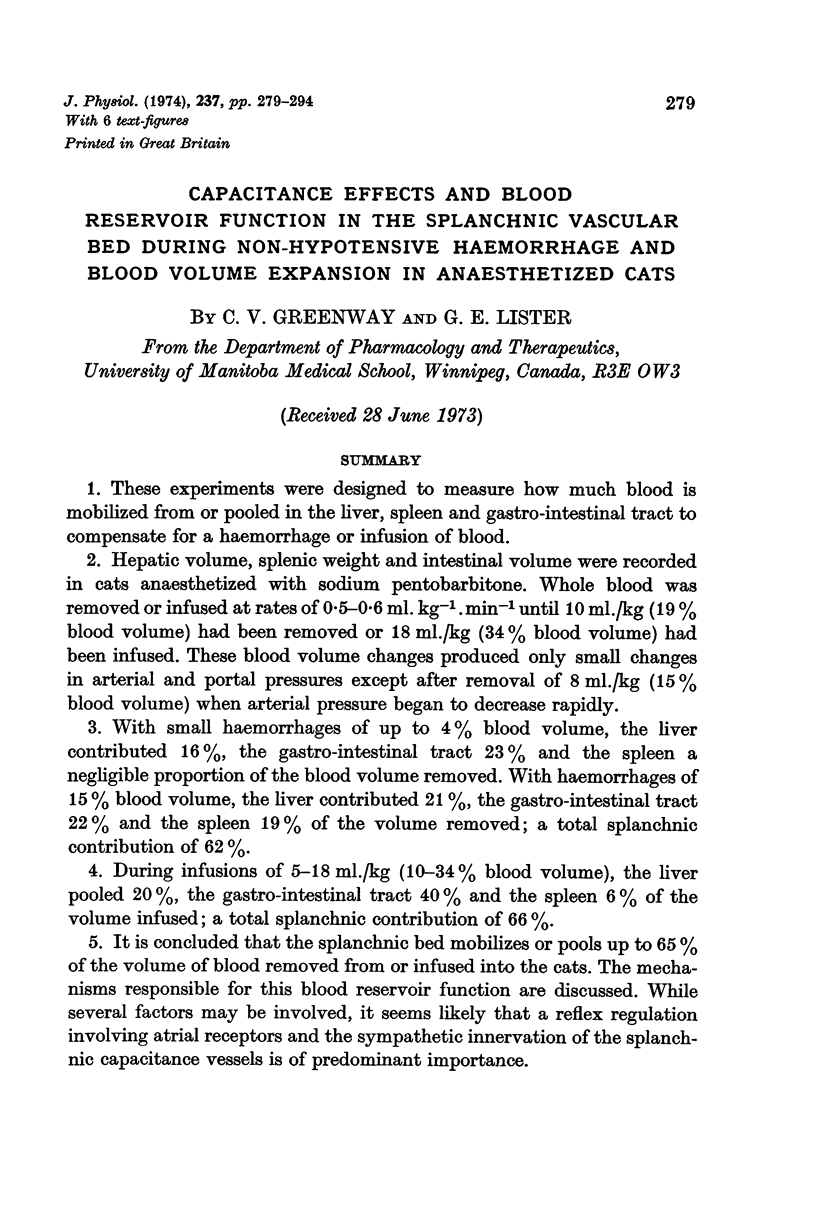
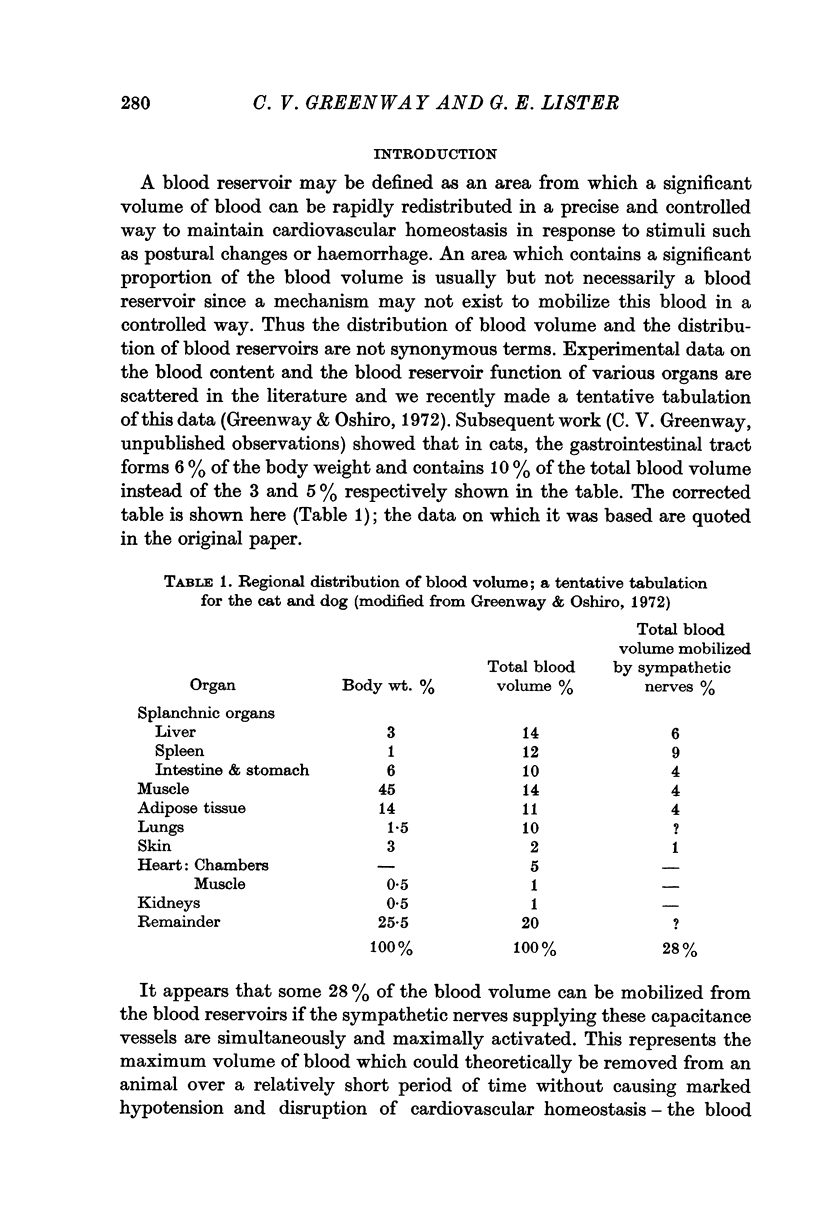
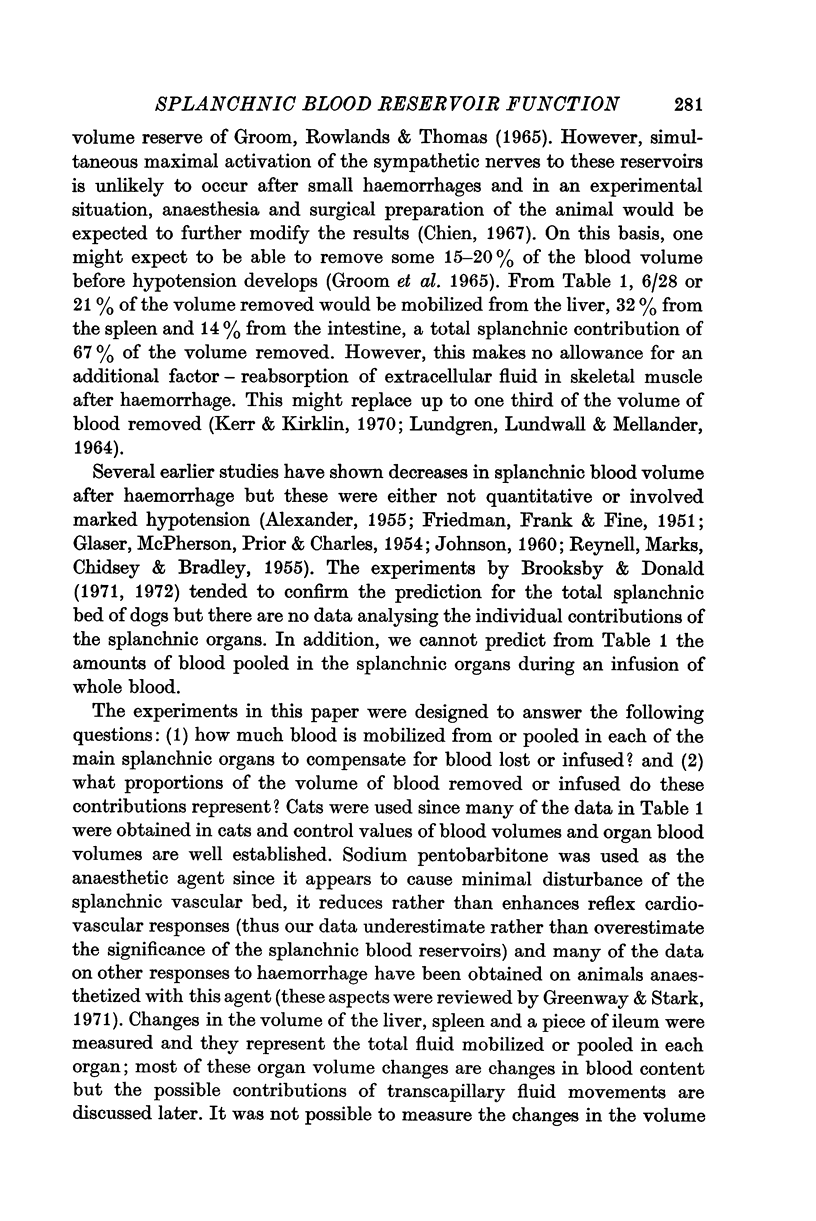
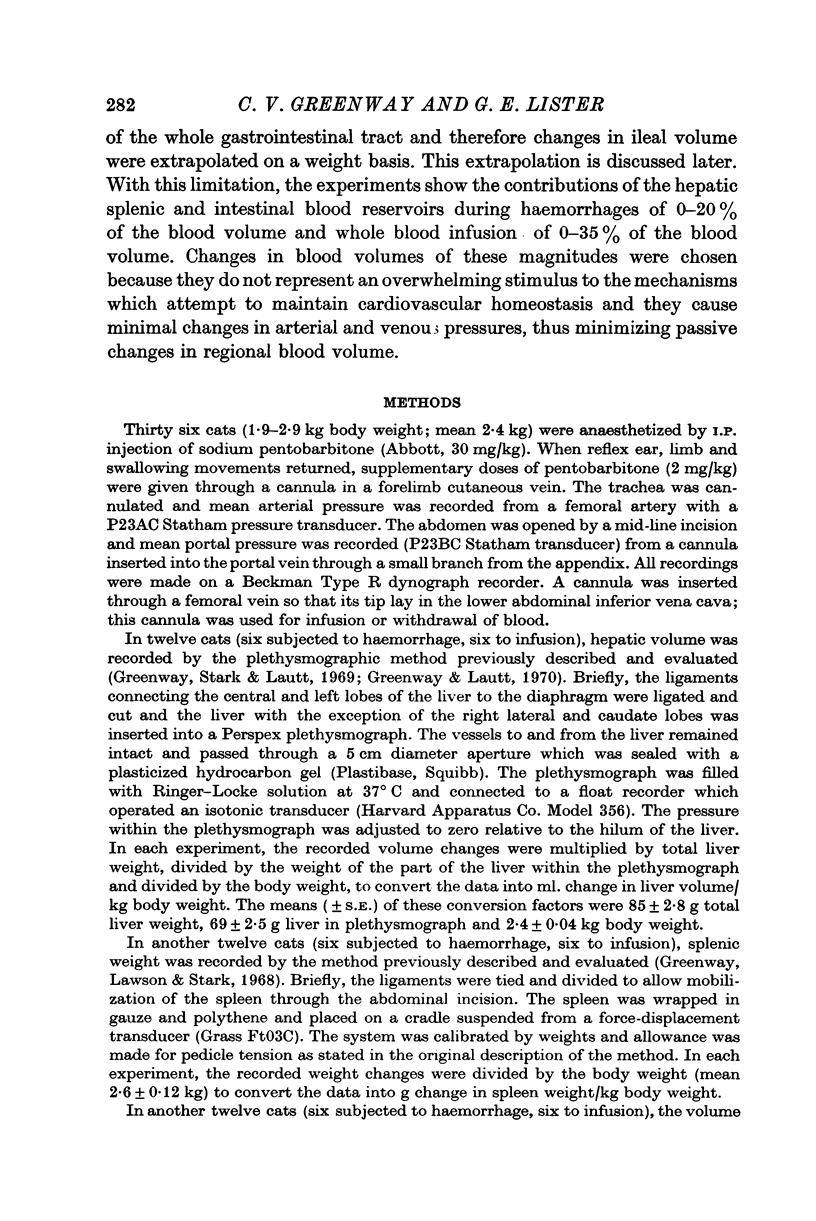
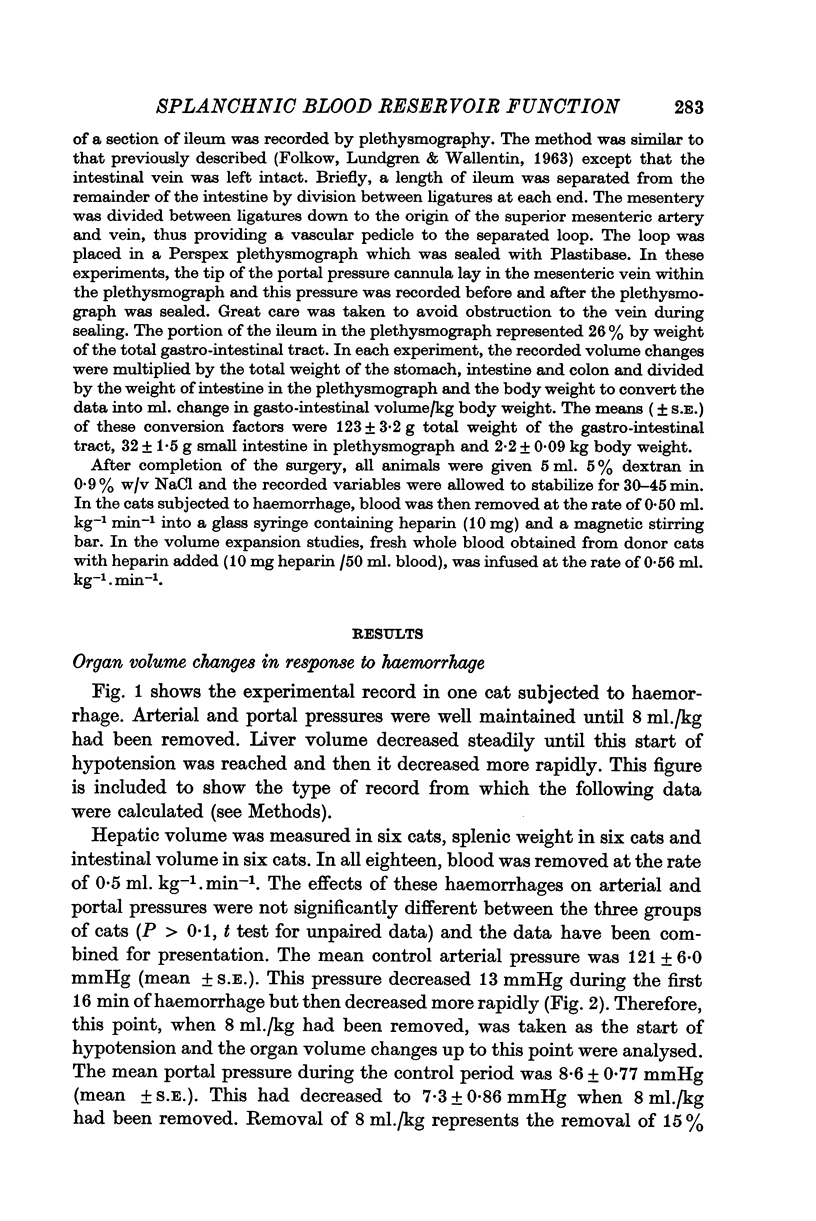
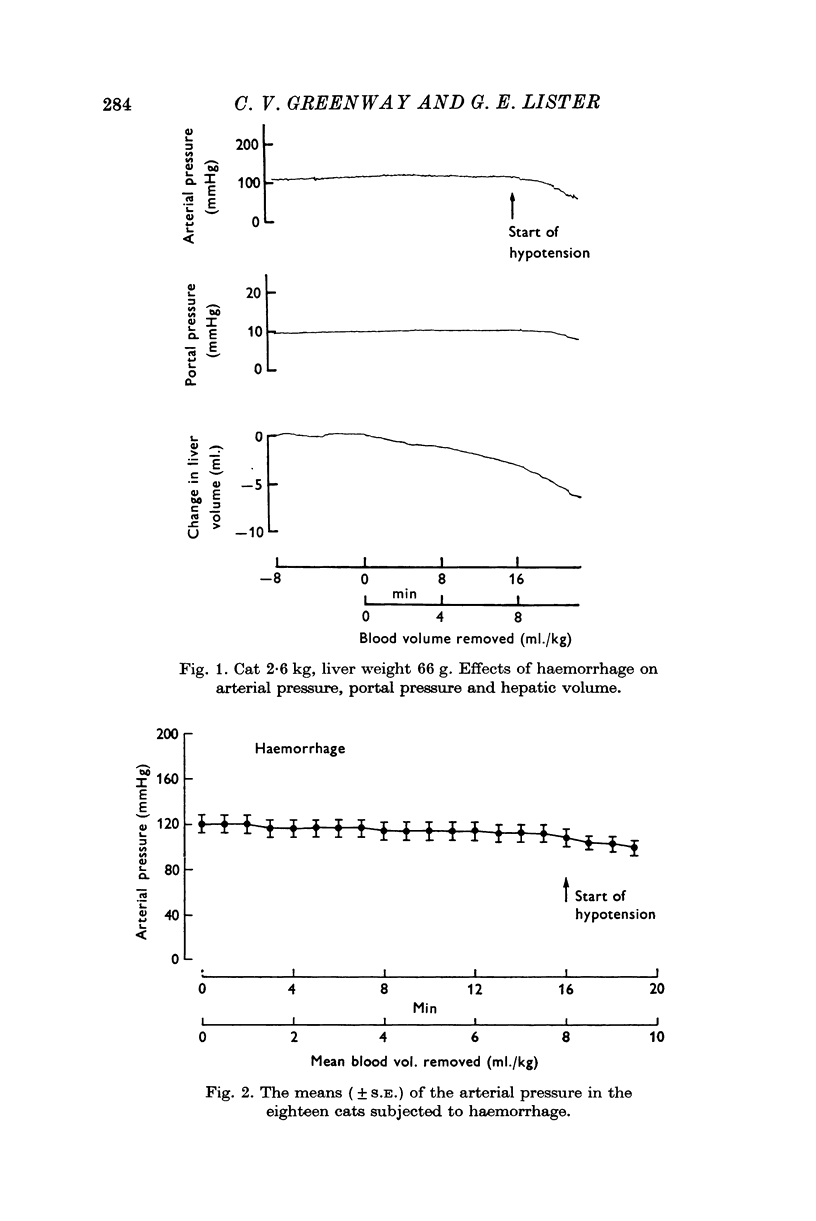
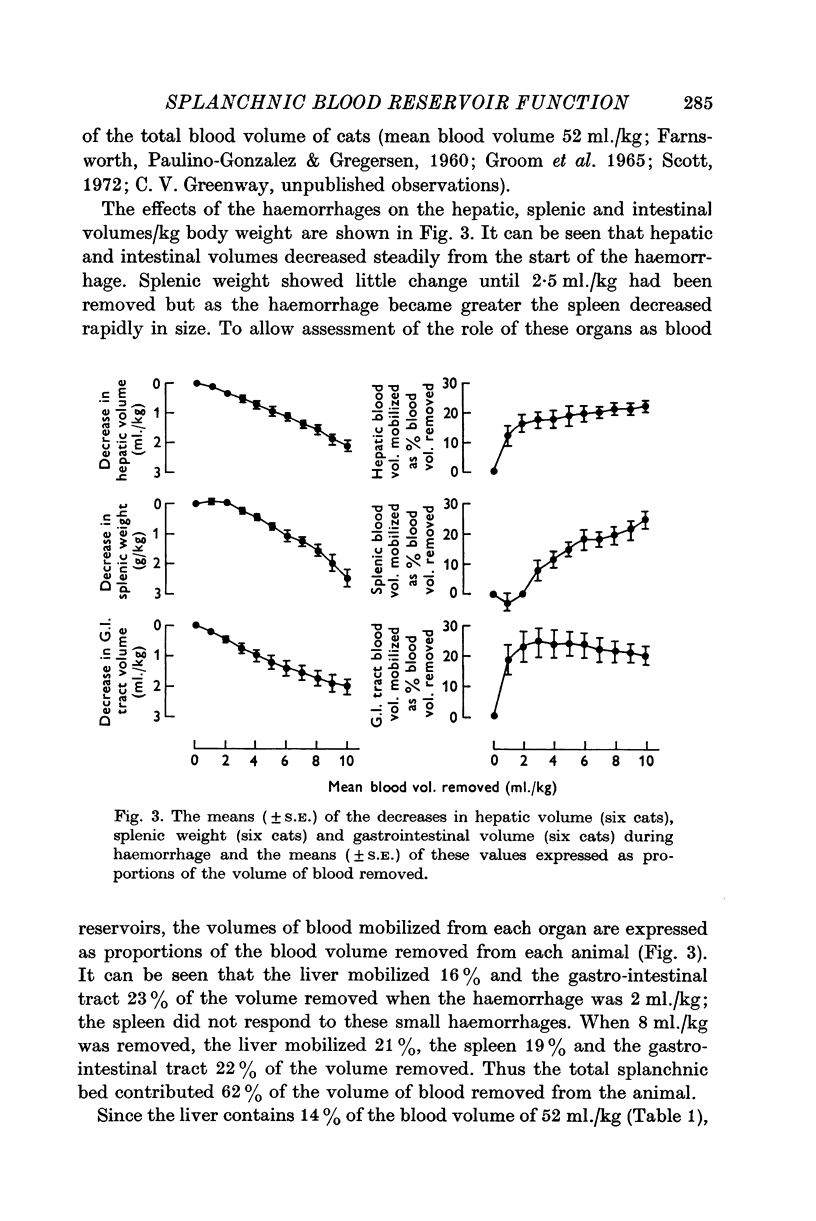
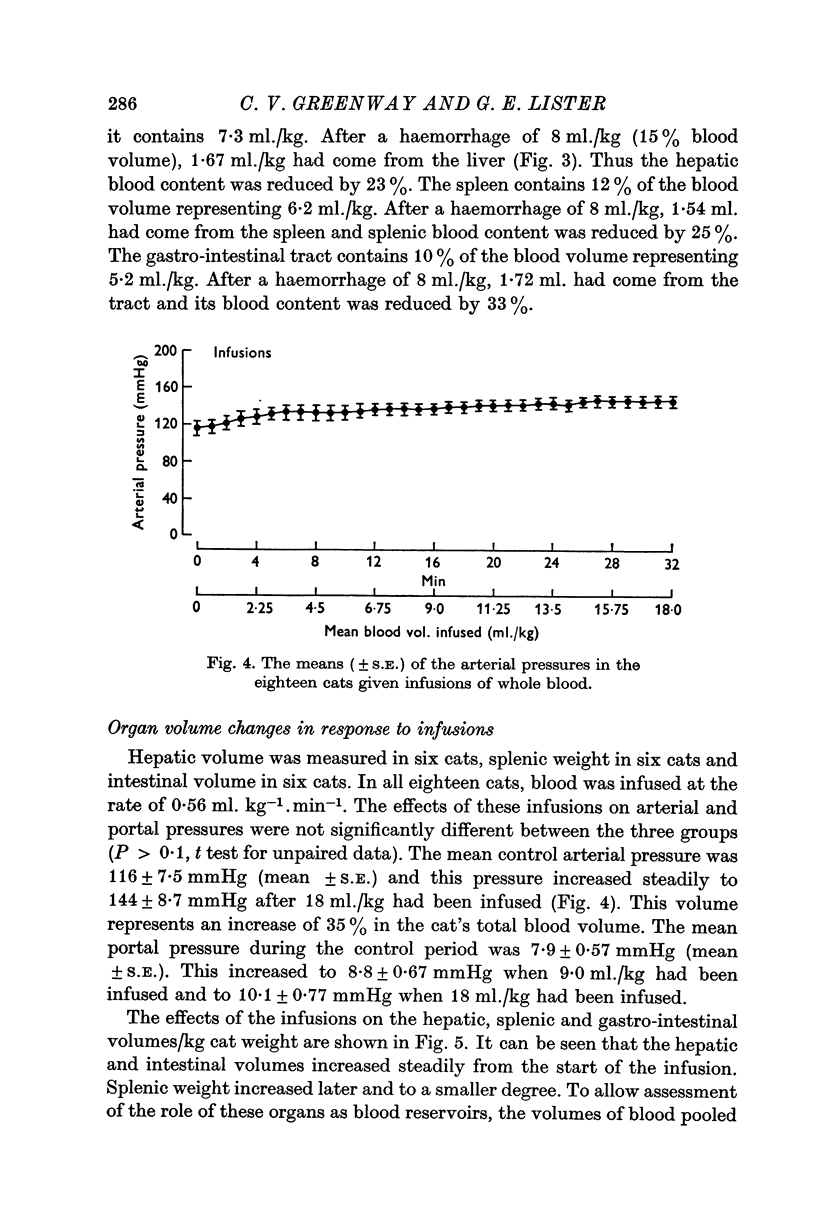
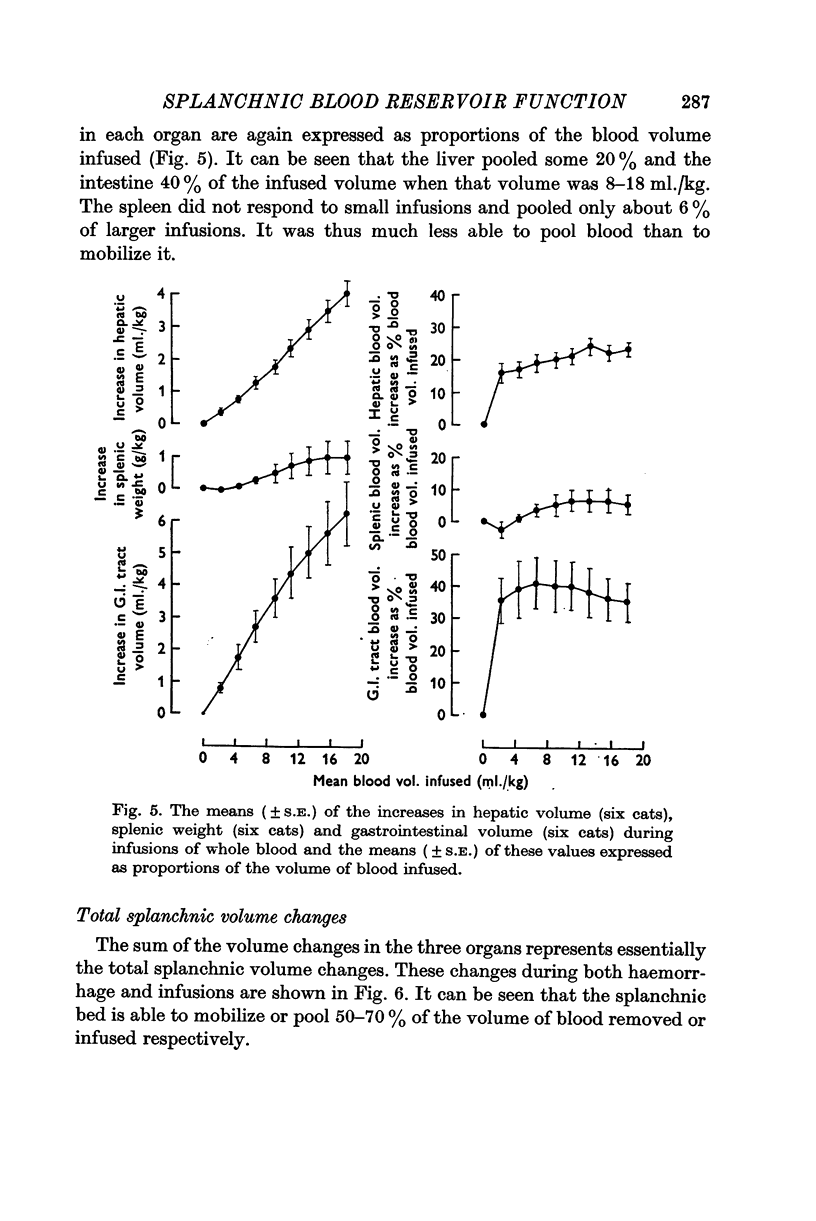
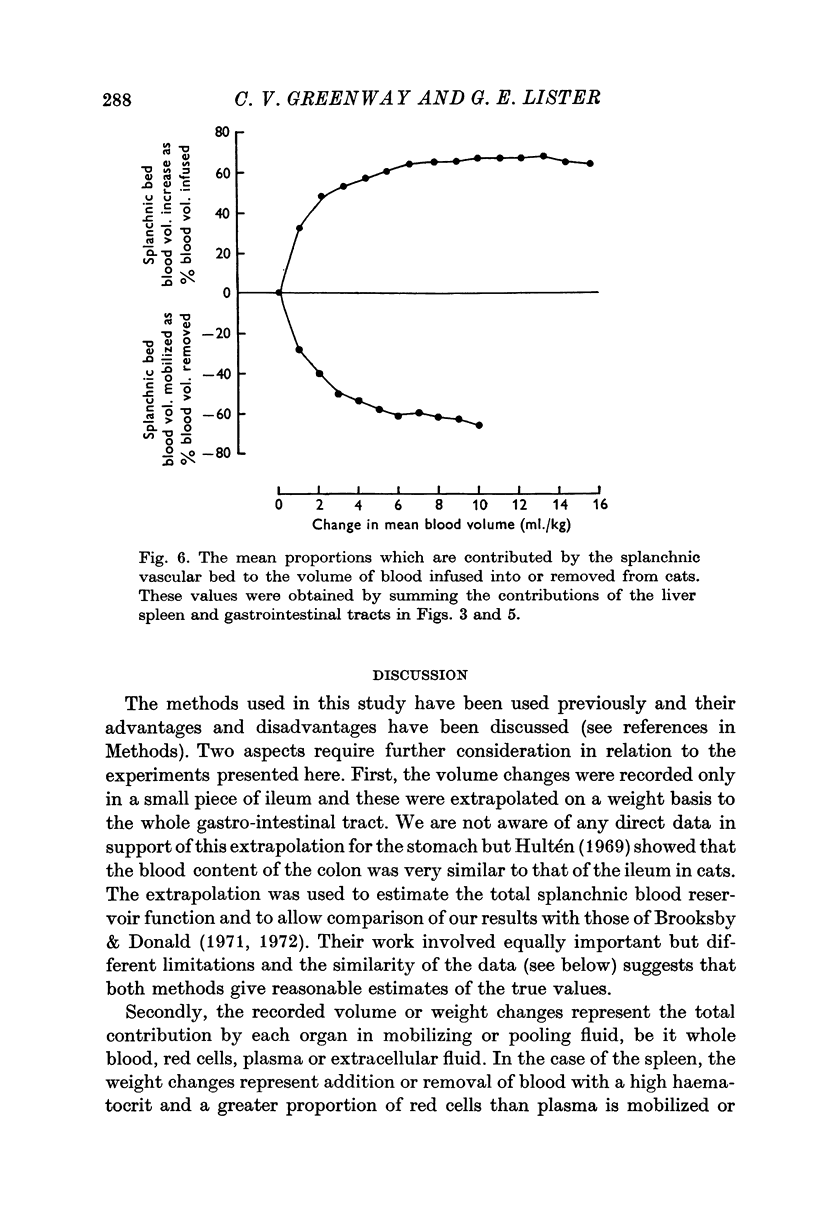
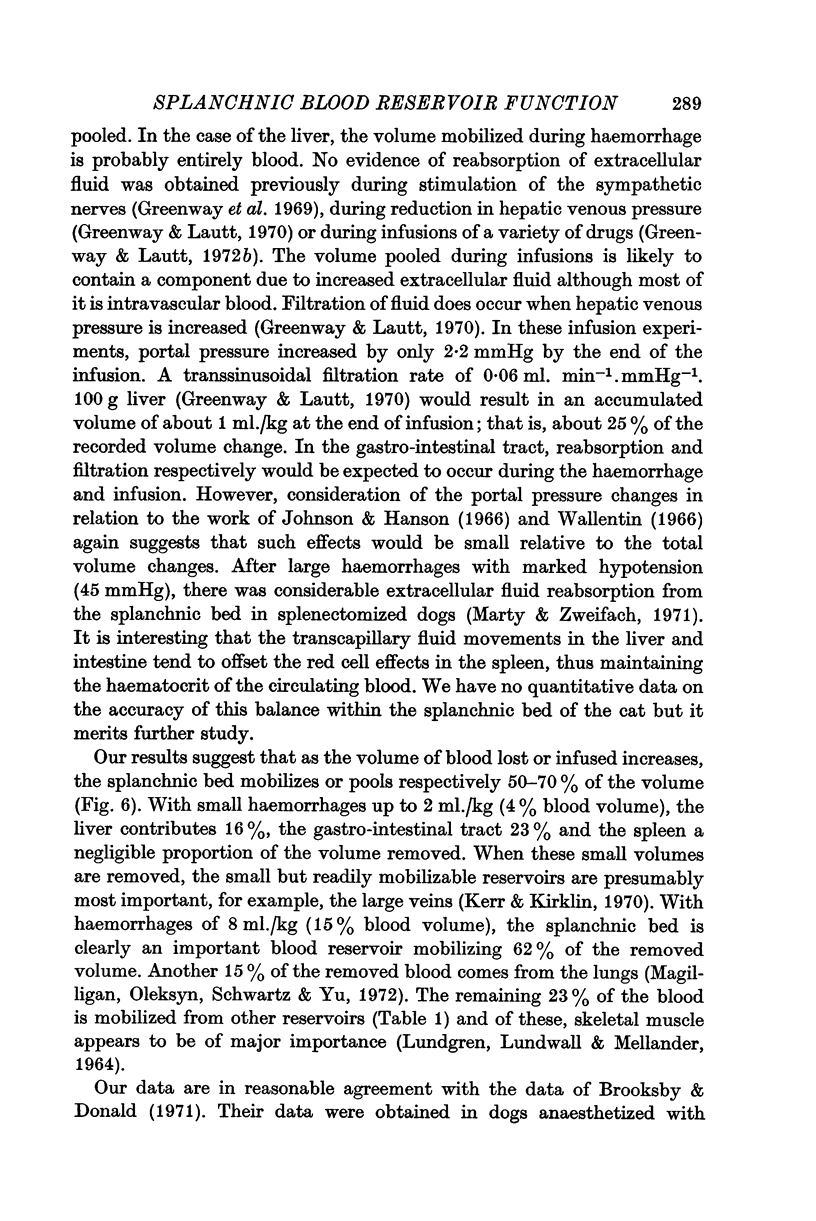
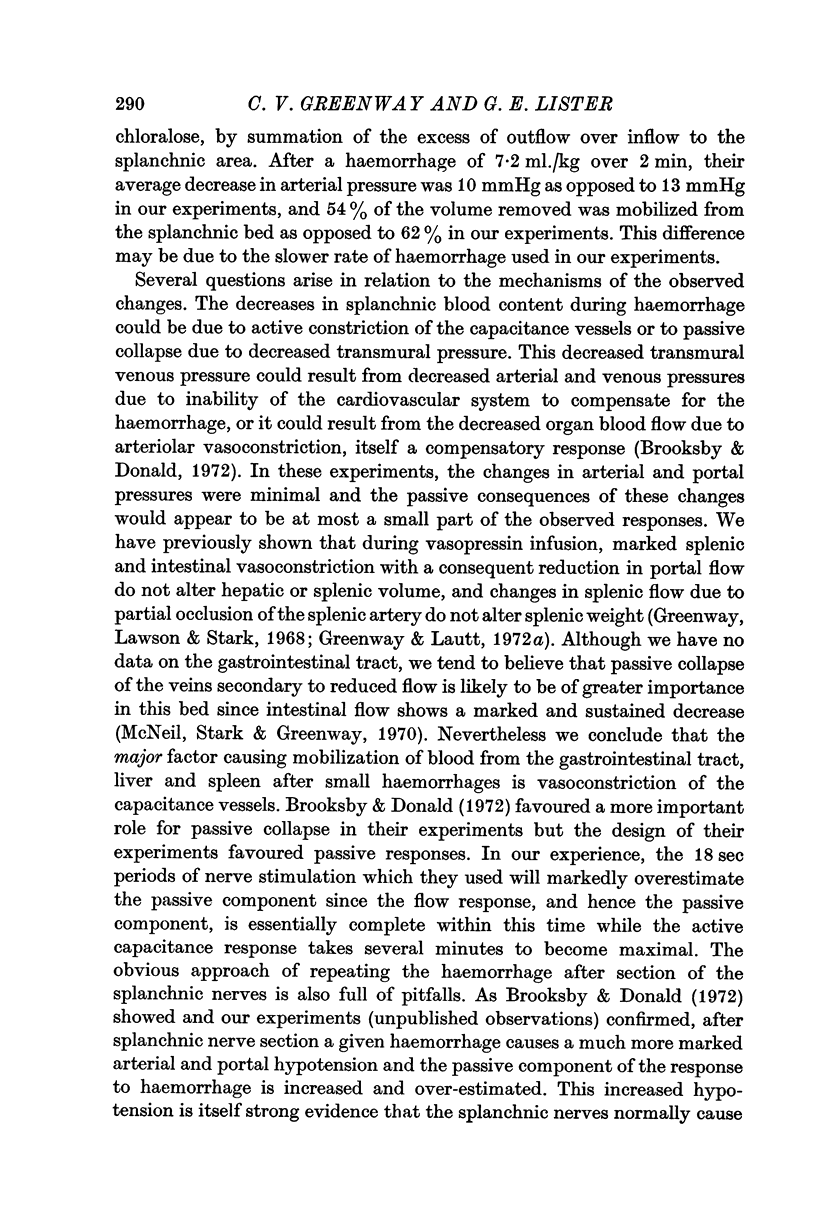
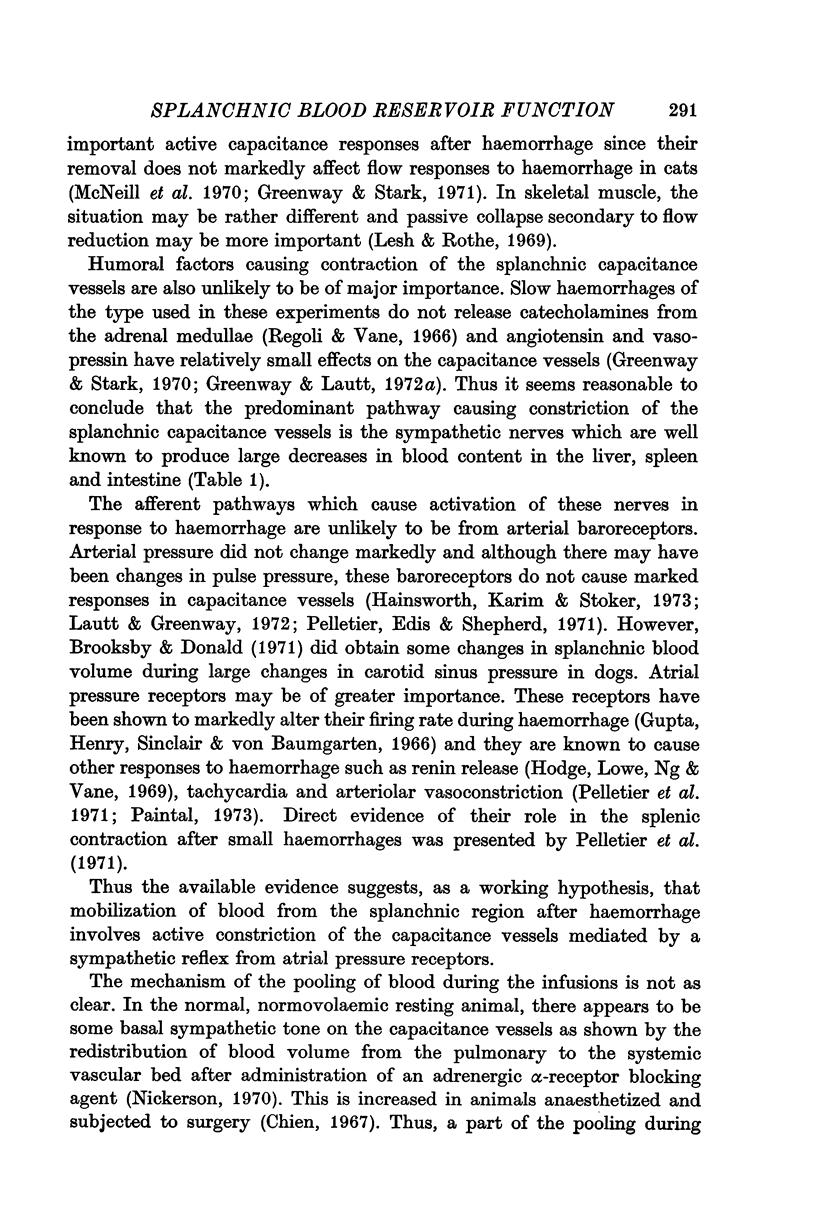

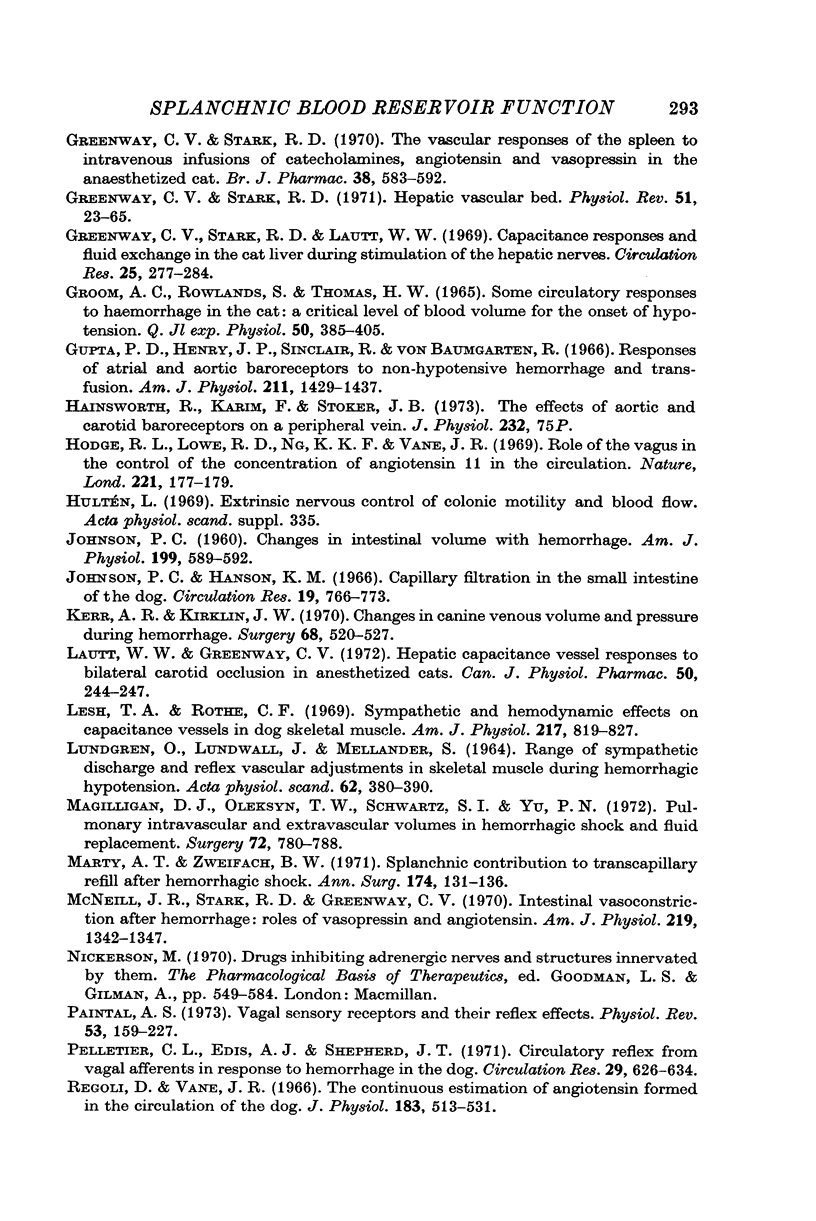
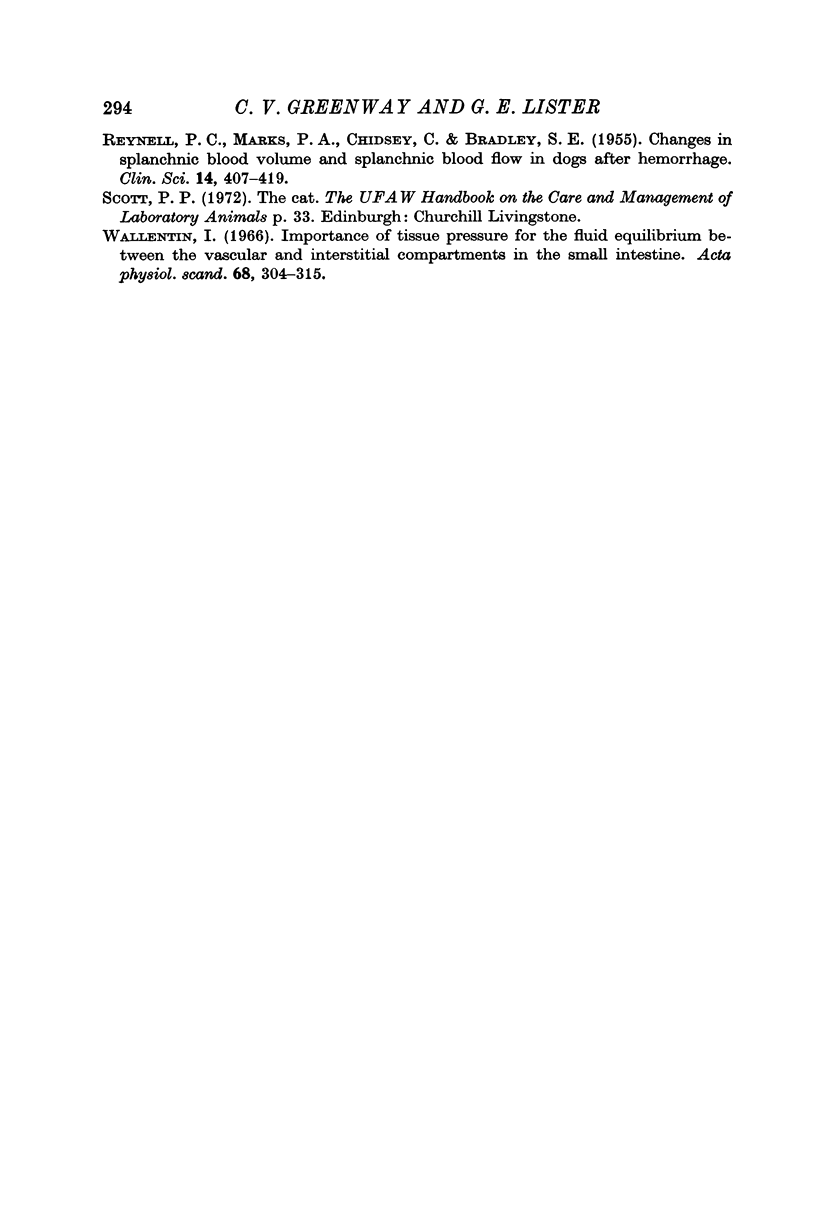
Selected References
These references are in PubMed. This may not be the complete list of references from this article.
- ALEXANDER R. S. Venomotor tone in hemorrhage and shock. Circ Res. 1955 Mar;3(2):181–190. doi: 10.1161/01.res.3.2.181. [DOI] [PubMed] [Google Scholar]
- Brooksby G. A., Donald D. E. Dynamic changes in splanchnic blood flow and blood volume in dogs during activation of sympathetic nerves. Circ Res. 1971 Sep;29(3):227–238. doi: 10.1161/01.res.29.3.227. [DOI] [PubMed] [Google Scholar]
- Brooksby G. A., Donald D. E. Release of blood from the splanchnic circulation in dogs. Circ Res. 1972 Jul;31(1):105–118. doi: 10.1161/01.res.31.1.105. [DOI] [PubMed] [Google Scholar]
- Chien S. Role of the sympathetic nervous system in hemorrhage. Physiol Rev. 1967 Apr;47(2):214–288. doi: 10.1152/physrev.1967.47.2.214. [DOI] [PubMed] [Google Scholar]
- FARNSWORTH P. N., PAULINO-GONZALEZ C. M., GREGERSEN M. I. F-cells values in the normal and splenectomized cat: relation of F-cells to body size. Proc Soc Exp Biol Med. 1960 Aug-Sep;104:729–733. doi: 10.3181/00379727-104-25968. [DOI] [PubMed] [Google Scholar]
- FOLKOW B., LUNDGREN O., WALLENTIN I. Studies on the relationship between flow resistance, capillary filtration coefficient and regional blood volume in the intestine of the cat. Acta Physiol Scand. 1963 Mar;57:270–283. doi: 10.1111/j.1748-1716.1963.tb02591.x. [DOI] [PubMed] [Google Scholar]
- FRIEDMAN E. W., FRANK H. A., FINE J. Portal circulation in experimental hemorrhagic shock; in vivo roentgen ray studies. Ann Surg. 1951 Jul;134(1):70–79. doi: 10.1097/00000658-195107000-00008. [DOI] [PMC free article] [PubMed] [Google Scholar]
- GLASER E. M., McPHERSON D. R., PRIOR K. M., CHARLES E. Radiological investigation of the effects of haemorrhage on the lungs, liver and spleen, with special reference to the storage of blood in man. Clin Sci. 1954 Nov;13(4):461–474. [PubMed] [Google Scholar]
- Greenway C. V., Lautt W. W. Effects of adrenaline, isoprenaline and histamine on transsinusoidal fluid filtration in the cat liver. Br J Pharmacol. 1972 Feb;44(2):185–191. doi: 10.1111/j.1476-5381.1972.tb07254.x. [DOI] [PMC free article] [PubMed] [Google Scholar]
- Greenway C. V., Lautt W. W. Effects of hepatic venous pressure on transsinusoidal fluid transfer in the liver of the anesthetized cat. Circ Res. 1970 Jun;26(6):697–703. doi: 10.1161/01.res.26.6.697. [DOI] [PubMed] [Google Scholar]
- Greenway C. V., Lautt W. W. Effects of infusions of catecholamines, angiotensin, vasopressin and histamine on hepatic blood volume in the anaesthetized cat. Br J Pharmacol. 1972 Feb;44(2):177–184. doi: 10.1111/j.1476-5381.1972.tb07253.x. [DOI] [PMC free article] [PubMed] [Google Scholar]
- Greenway C. V., Lawson A. E., Stark R. D. Vascular responses of the spleen to nerve stimulation during normal and reduced blood flow. J Physiol. 1968 Feb;194(2):421–433. doi: 10.1113/jphysiol.1968.sp008416. [DOI] [PMC free article] [PubMed] [Google Scholar]
- Greenway C. V., Oshiro G. Comparison of the effects of hepatic nerve stimulation on arterial flow, distribution of arterial and portal flows and blood content in the livers of anaesthetized cats and dogs. J Physiol. 1972 Dec;227(2):487–501. doi: 10.1113/jphysiol.1972.sp010044. [DOI] [PMC free article] [PubMed] [Google Scholar]
- Greenway C. V., Stark R. D. Hepatic vascular bed. Physiol Rev. 1971 Jan;51(1):23–65. doi: 10.1152/physrev.1971.51.1.23. [DOI] [PubMed] [Google Scholar]
- Greenway C. V., Stark R. D., Lautt W. W. Capacitance responses and fluid exchange in the cat liver during stimulation of the hepatic nerves. Circ Res. 1969 Sep;25(3):277–284. doi: 10.1161/01.res.25.3.277. [DOI] [PubMed] [Google Scholar]
- Greenway C. V., Stark R. D. The vascular responses of the spleen to intravenous infusions of catecholamines, angiotensin and vasopressi in the anaesthetized cat. Br J Pharmacol. 1970 May;38(3):583–592. doi: 10.1111/j.1476-5381.1970.tb10599.x. [DOI] [PMC free article] [PubMed] [Google Scholar]
- Groom A. C., Rowlands S., Thomas H. W. Some circulatory responses to haemorrhage in the cat: a critical level of blood volume for the onset of hypotension. Q J Exp Physiol Cogn Med Sci. 1965 Oct;50(4):385–405. doi: 10.1113/expphysiol.1965.sp001805. [DOI] [PubMed] [Google Scholar]
- Gupta P. D., Henry J. P., Sinclair R., Von Baumgarten R. Responses of atrial and aortic baroreceptors to nonhypotensive hemorrhage and to tranfusion. Am J Physiol. 1966 Dec;211(6):1429–1437. doi: 10.1152/ajplegacy.1966.211.6.1429. [DOI] [PubMed] [Google Scholar]
- Hainsworth R., Karim F., Stoker J. D. The effects of aortic and carotid baroreceptors on a peripheral vein. J Physiol. 1973 Jul;232(2):75P–76P. [PubMed] [Google Scholar]
- Hodge R. L., Lowe R. D., Ng K. K., Vane J. R. Role of the vagus nerve in the control of the concentration of angiotensin II in the circulation. Nature. 1969 Jan 11;221(5176):177–179. doi: 10.1038/221177a0. [DOI] [PubMed] [Google Scholar]
- Johnson P. C., Hanson K. M. Capillary filtration in the small intestine of the dog. Circ Res. 1966 Oct;19(4):766–773. doi: 10.1161/01.res.19.4.766. [DOI] [PubMed] [Google Scholar]
- Kerr A. R., Kirklin J. W. Changes in canine venous volume and pressure during hemorrhage. Surgery. 1970 Sep;68(3):520–527. [PubMed] [Google Scholar]
- LUNDGREN O., LUNDWALL J., MELLANDER S. RANGE OF SYMPATHETIC DISCHARGE AND REFLEX VASCULAR ADJUSTMENTS IN SKELETAL MUSCLE DURING HEMORRHAGIC HYPOTENSION. Acta Physiol Scand. 1964 Dec;62:380–390. doi: 10.1111/j.1748-1716.1964.tb10436.x. [DOI] [PubMed] [Google Scholar]
- Lautt W. W., Greenway C. V. Hepatic capacitance vessel responses to bilateral carotid occlusion in anesthetized cats. Can J Physiol Pharmacol. 1972 Mar;50(3):244–247. doi: 10.1139/y72-036. [DOI] [PubMed] [Google Scholar]
- Lesh T. A., Rothe C. F. Sympathetic and hemodynamic effects on capacitance vessels in dog skeletal muscle. Am J Physiol. 1969 Sep;217(3):819–827. doi: 10.1152/ajplegacy.1969.217.3.819. [DOI] [PubMed] [Google Scholar]
- Magilligan D. J., Jr, Oleksyn T. W., Schwartz S. I., Yu P. N. Pulmonary intravascular and extravascular volumes in hemorrhagic shock and fluid replacement. Surgery. 1972 Nov;72(5):780–788. [PubMed] [Google Scholar]
- Marty A. T., Zweifach B. W. Splanchnic contribution to transcapillary refill after hemorrhagic shock. Ann Surg. 1971 Jul;174(1):131–136. doi: 10.1097/00000658-197107010-00021. [DOI] [PMC free article] [PubMed] [Google Scholar]
- McNeill J. R., Stark R. D., Greenway C. V. Intestinal vasoconstriction after hemorrhage: roles of vasopressin and angiotensin. Am J Physiol. 1970 Nov;219(5):1342–1347. doi: 10.1152/ajplegacy.1970.219.5.1342. [DOI] [PubMed] [Google Scholar]
- Paintal A. S. Vagal sensory receptors and their reflex effects. Physiol Rev. 1973 Jan;53(1):159–227. doi: 10.1152/physrev.1973.53.1.159. [DOI] [PubMed] [Google Scholar]
- Pelletier C. L., Edis A. J., Shepherd J. T. Circulatory reflex from vagal afferents in response to hemorrhage in the dog. Circ Res. 1971 Dec;29(6):626–634. doi: 10.1161/01.res.29.6.626. [DOI] [PubMed] [Google Scholar]
- REYNELL P. C., MARKS P. A., CHIDSEY C., BRADLEY S. E. Changes in splanchnic blood volume and splanchnic blood flow in dogs after haemorrhage. Clin Sci. 1955 Aug;14(3):407–419. [PubMed] [Google Scholar]
- Regoli D., Vane J. R. The continuous estimation of angiotensin formed in the circulation of the dog. J Physiol. 1966 Apr;183(3):513–531. doi: 10.1113/jphysiol.1966.sp007881. [DOI] [PMC free article] [PubMed] [Google Scholar]


